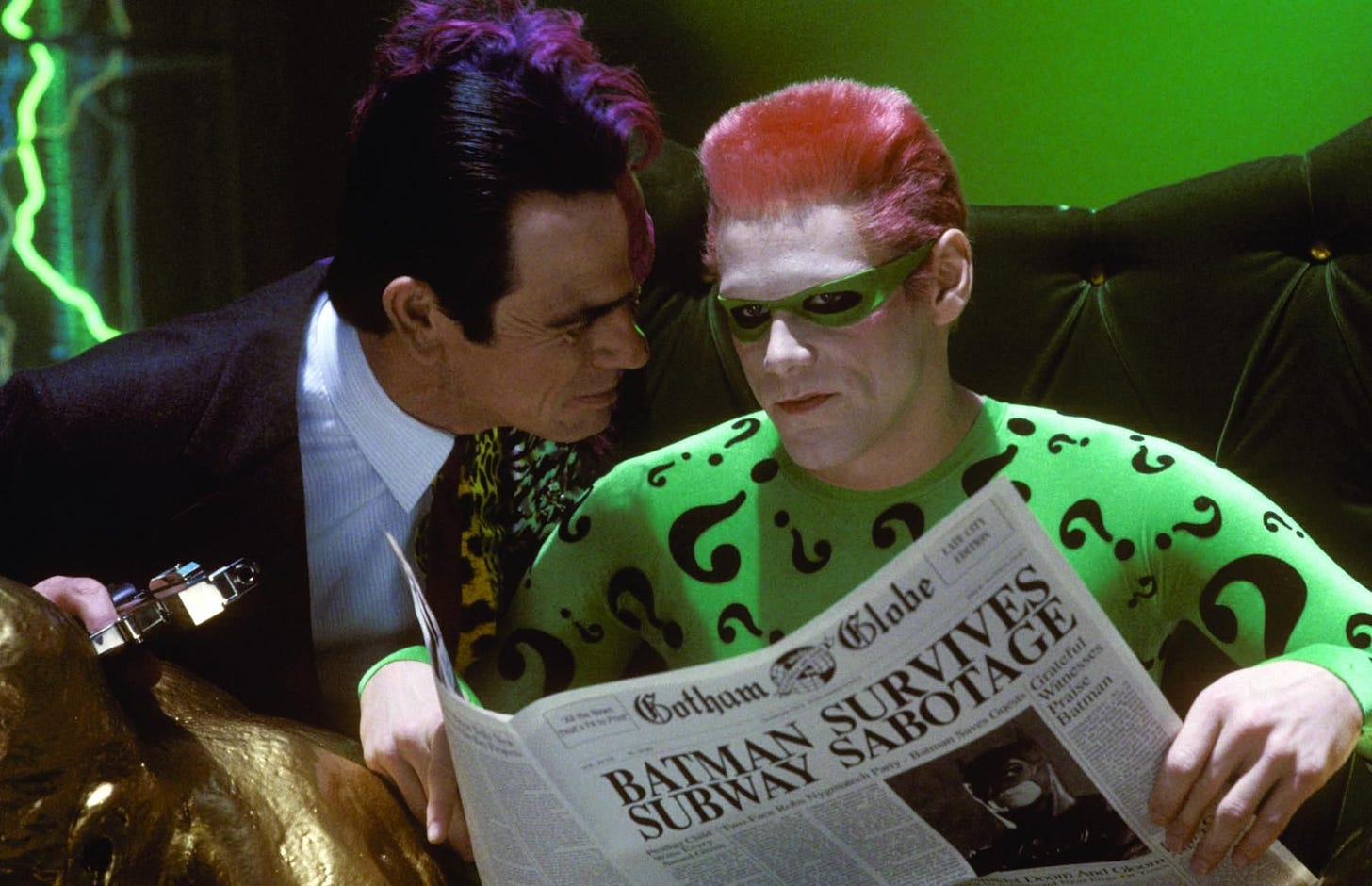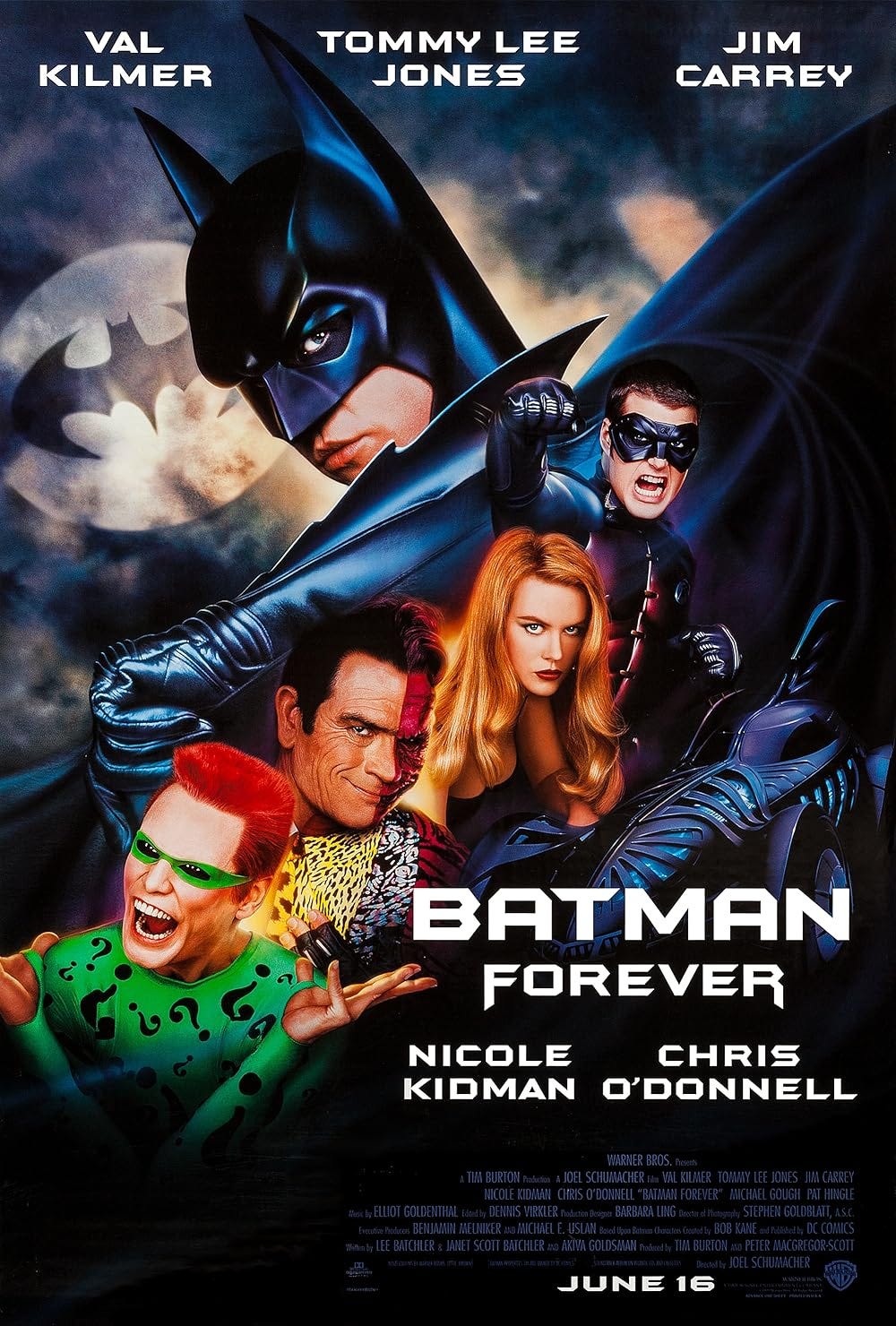Batman Forever (1995) is One of the Most Merchandisable Films of All Time
Guest post alert! Today’s newsletter was written by Matt Scalici, a longtime local journalist friend of mine. I’m actually ashamed that it’s taken me this long to rope Matt into writing a guest piece because he’s a bona fide pop culture aficionado, as evidenced by his great work on the For The Watercooler podcast that he co-hosts with Caroline Darney. They’ve put together an amazing slate of guests that includes Spencer Hall and Ryan Nanni of the Shutdown Fullcast and the screenwriters of hit films like Beetlejuice Beetlejuice and Inside Out 2. (And also yours truly!) Speaking of Ryan Nanni, Matt was also featured on a recent episode of his We’re Not All Like This podcast to discuss his lifelong love of Alabama football that turned into a career. Today he’s taking the reins to dive deep into a cinematic phenomenon that’s celebrating a 30th anniversary later this year. Take it away, Matt!
A few weeks ago, I found myself doing something lots of perfectly normal people with healthy brains do: wondering how I’m going to spend the year ahead. What kinds of changes I’m going to make to my life. What kinds of new habits I’ll try to form to become a healthier and more productive person.
What I landed on was this: I’m going to watch every movie released in 1995.
You’ve probably got a few questions right now, and I’ve prepared for them. Why 1995? Well, that was exactly 30 years ago and I like thinking about how much the world has changed in that span, not just from a technology and fashion standpoint but in more fundamental ways like our cultural values.
Next question. Every movie? Yes, every movie. I’m starting with the 50 highest grossing films at the domestic box office and then we’ll go from there.
But you need to understand I’m not doing this to pass the time. I’m doing this because there’s something broken in my brain that makes me incapable of enjoying anything unless I can complete it in a 100%, comprehensive, no-crumbs-left fashion.1
My favorite movie of 1995? It very well might be the most culturally significant movie of 1995, and frankly the most “1995” of all 1995 movies: Batman Forever.
After two gloriously unrestrained Batman films, Warner Bros. decided that the juggernaut Tim Burton had brought to life wasn’t quite maxing out its commercial potential. After all, it’s tough to move Happy Meal toys when the movie they’re promoting is rated R. Warner Bros. didn’t want another dark, violent Batman movie, and Burton didn’t want to be looking over his shoulder while directing a movie at the height of his career. The two mutually parted ways and Warner Bros. began looking for a new filmmaker to continue the franchise.
Enter Joel Schumacher, a director who had already made quite a name for himself in Hollywood with a string of odd, humor-tinged thrillers like The Lost Boys, Flatliners, and Falling Down. There would be no attempt to ease audiences out of Burton’s version of Gotham City. Whereas Burton drew on some of the darker portrayals of Batman, Schumacher presented a more light-hearted, colorful version of the character.2
But as we all know, it’s really the villains that make a Batman movie. And like its predecessor Batman Returns, this movie needed two villains.
First up, there’s Harvey Dent, a.k.a. Two-Face, a former district attorney turned madman. Burton had originally planned to feature Two-Face in his third Batman film, but he had a serious take on the character in mind. Schumacher instead cast Tommy Lee Jones to play a scenery-chewing version of the character that evokes Yosemite Sam at times.3
All due respect to Tommy, but the real star of this movie—and the main attraction for me as a 12-year-old movie fan—was Jim Carrey as Edward Nigma, a.k.a. The Riddler. I’m not sure any actor has had a year quite like Jim Carrey did in 1994, which saw him in three legitimately huge comedy hits: The Mask, Dumb & Dumber, and Ace Ventura: Pet Detective. By the end of the year, Carrey was the biggest actor in Hollywood. Shortly after the release of Batman Forever, he became the first movie star to receive an upfront paycheck of $20 million for a single role.
Losing Burton also meant losing Michael Keaton, which was a genuine bummer. I believe his performances in both Batman movies are severely underrated. Warner Bros. wound up with Val Kilmer as the titular hero and Nicole Kidman as the love interest, two perfectly respectable big stars in their day, along with relative newcomer Chris O’Donnell as Robin, a new addition to the film franchise.
The movie itself is a colorful, wacky caper with Batman and Robin using all manner of gadgets and vehicles to fight two absolutely ridiculous villains in a plot that lightly satirizes America’s brain-numbing media consumption habits.4 In a vacuum, it’s not a particularly earth-shattering or game-changing movie. But exactly zero people saw this movie in a vacuum.
Batman Forever took up massive real estate in my preteen brain during the months leading up to the summer of 1995—and that was by design. It was, for its era, perhaps the most broadly and intensely marketed movie of all time. Producer Peter McGregor-Scott was a man with a vision, and that vision was to create the most merchandisable film in Hollywood history. Everything about this movie, from the costume design choices to the soundtrack, was specifically designed to create a desire in the viewer to buy.
It was a different way of looking at movies. Batman Forever wasn’t just a film. It was a nuclear power plant at the center of an entire industry. The box office take that year was great (with Batman Forever earning a substantial $336 million worldwide), but that was only the beginning. McDonald’s collectible glasses, Six Flags rides, Kenner action figures, Super Nintendo games—if you were 12 years old in 1995, this movie was hitting you where it counted, its branding plastered over all the things that brought you joy.
The soundtrack deserves its own special consideration. Like everything else with Batman Forever, there was nothing organic about this album. It was created from scratch to move units; only five of the songs are actually used in the film. This was mostly an opportunity for Atlantic Records to get some of its biggest artists into the ears of eager listeners. There’s no theme to the tracks on this album. It’s simply a grab bag of random artists, from U2 and The Offspring to Brandy and Method Man.
It’s hard to imagine anyone involved knew that the song “Kiss From a Rose” would explode quite the way it did when they were putting this soundtrack together. Seal’s epic pop ballad just seemed to hit the cultural zeitgeist at the exact right moment while also getting a push from the most powerful marketing machine the entertainment industry had ever built. The song was absolutely unavoidable in 1995, hitting #1 on the charts and going on to win three Grammys.
With all of that marketing in mind, the movie itself is a genuinely fun piece of pop culture. Schumacher would lean even further into goofy camp with Batman & Robin, but I really think Batman Forever strikes a pretty great balance between recognizing both the coolness and absurdity of a live-action movie about a caped crusader.
McGregor-Scott’s sales-focused approach to filmmaking and the wild success it led to would obviously not be a one-time aberration. In fact, it’s now standard operating procedure for how most of the remaining major studios create and market movies today. But I can’t help but feel that despite the cynical, capitalistic nature of the marketing push around Batman Forever, there was some genuine excitement behind it that doesn’t exist in modern movie marketing.
Our Batman Forever summer was about having fun in as many different ways as possible. The promotional tie-ins were things that you’d genuinely enjoy as a fan of Batman! Val Kilmer wasn’t showing up in ads for cars that only C-suite executives can afford, he was advertising half-price admission at Six Flags to ride the new Batman roller coaster!
It’s impossible to say that the unbridled commercialism of the 90s was completely innocent, if only because it led to where we find ourselves now. But it did feel more populist, more inclusive, and more focused on having a good time rather than simply going through the motions of handing over your money to a giant corporation in exchange for the latest iteration of a product.
Batman Forever remains a perfectly preserved specimen of a time when capitalism was fun, when summer movies took over our brains, and when a day at the movies was an essential part of just about every weekend.
Batman Forever is now streaming on Max, and it is available to rent elsewhere.
I’m chronicling all these movies as I watch them on my TikTok account, as long as that platform continues to operate. But Jeremy’s invitation to write this guest column gave me an opportunity to go in depth here.
Burton leaned on the original 1930s depiction of Batman by Bill Finger and Bob Kane as well as the early 80s comics by Frank Miller. Conversely, Schumacher was inspired by the work of comic artist Dick Sprang (what a name) for his campy, cartoonish take on the Batman universe.
Tommy Lee Jones in a movie featuring a psychotic killer who flips a coin to decide his victims’ fates? How about that.
God, if they only knew how much worse it would get.





As someone with heavy OCD tendencies and highly questionable motives, I fully appreciate the dedication to the 1995 project.
Batman Forever is one of those movies that I forget exists until someone mentions it and the image of the batsuit's nipples goes off like a flashbang inside my brain. Great film.